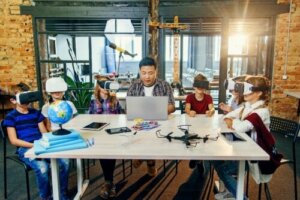What is Adaptive Learning?


Written and verified by the pedagogue and trainer María Matilde
How many times have you heard young people say that they never learn anything useful at school? And if we stop to think about it, they’re probably right about a lot of the content they have to study. Schools don’t teach all the skills and content needed for life today. And teaching isn’t adapted to the needs and interests of each student. Therefore, in an attempt to respond to these problems, an educational trend known as adaptive learning is gaining momentum.
Can you imagine if education truly responded to the needs of each student? And not only that, what if it actually motivated students and truly prepared them for life in our modern world?
Well, specifically, adaptive learning is a method that, with the help of ICT (Information and Communication Technologies), aims to personalize training. It’s personalized learning that adapts to what each student needs in order to continue learning and progressing. And, what’s more, in order to make education more attractive, it also takes into account their interests and motivations.
What is adaptive learning?
The educational method of adaptive learning is based on computer algorithms to help plan teaching and provide personalized lessons. This involves planning and delivering activities and resources tailored to the needs of each individual learner.

Technology at the service of teaching and learning adaptation
Thanks to ICT, it’s much easier to carry out an adaptive learning method. That’s because the teacher, through various applications and programs, can collect, store, and compare data that are produced during the learning processes of their students. In this sense, there are programs such as LearnSmart, which provide data on the personalized learning experiences of students.
In addition, all of these programs, applications, and platforms constitute the so-called VLEs (Virtual Learning Environments). These are spaces that exist on the Internet to promote exchanges and encourage interaction between teachers and students, both inside and outside the classroom, during school hours.
Therefore, technology at the service of adaptive learning allows teachers to monitor the learning of their students and know their progress. And, at the same time, it allows them to provide their students with new content, activities, and tasks that are always appropriate to their level and learning situation.
Therefore, we’re talking about an interesting pedagogical trend based on the use of technology to personalize teaching, so that students of all educational levels can meet their learning demands. And this can take place almost immediately and they can access adapted learning paths.
The main characteristics of adaptive learning
The main characteristics of adaptive learning or, in any case, of personalized teaching are as follows:
- Taking into consideration the form, pace, learning, and study needs of each learner
- Reducing the quantity of information and content while at the same time personalizing it
- Verifying the student’s understanding of the contents, through almost immediate and constant feedback with their educators
- Compensating for weaknesses and developing or enhancing competencies and skills
- Increasing students’ motivation and interest in learning

The benefits of personalized teaching
The main benefits of adaptive learning include the following:
- Optimized learning, as planning is in accordance with the needs of each student.
- It’s a method that’s suitable for any age and educational level. What’s more, it’s applicable to any area of knowledge.
- Adaptive learning increases the student’s level of motivation to learn. The teaching of a subject is produced from contents that are attractive or that produce interest for the student.
- What’s more, it increases the level of commitment and the involvement of students in their own learning process. That’s because, when dealing with content and issues that are interesting to them, their learning’s a challenge rather than a simple internalization and memorization of contents.
Increasingly adaptive learning, the future of education
The use of training methodologies, such as adaptive learning, is the future of education. Technological advances and constant social changes in all spheres demand an education that’s up to the task and that’s capable of training creative, autonomous, and adaptive citizens.
Achieving greater personalization and independence in the learning process is one of the challenges facing educational institutions. Therefore, it’s essential to provide ongoing training for all educators.
This training must be technical and include how to operate technological applications. At the same time, it must also train educators on the functionality of these technological applications in order to make adaptive learning possible.
How many times have you heard young people say that they never learn anything useful at school? And if we stop to think about it, they’re probably right about a lot of the content they have to study. Schools don’t teach all the skills and content needed for life today. And teaching isn’t adapted to the needs and interests of each student. Therefore, in an attempt to respond to these problems, an educational trend known as adaptive learning is gaining momentum.
Can you imagine if education truly responded to the needs of each student? And not only that, what if it actually motivated students and truly prepared them for life in our modern world?
Well, specifically, adaptive learning is a method that, with the help of ICT (Information and Communication Technologies), aims to personalize training. It’s personalized learning that adapts to what each student needs in order to continue learning and progressing. And, what’s more, in order to make education more attractive, it also takes into account their interests and motivations.
What is adaptive learning?
The educational method of adaptive learning is based on computer algorithms to help plan teaching and provide personalized lessons. This involves planning and delivering activities and resources tailored to the needs of each individual learner.

Technology at the service of teaching and learning adaptation
Thanks to ICT, it’s much easier to carry out an adaptive learning method. That’s because the teacher, through various applications and programs, can collect, store, and compare data that are produced during the learning processes of their students. In this sense, there are programs such as LearnSmart, which provide data on the personalized learning experiences of students.
In addition, all of these programs, applications, and platforms constitute the so-called VLEs (Virtual Learning Environments). These are spaces that exist on the Internet to promote exchanges and encourage interaction between teachers and students, both inside and outside the classroom, during school hours.
Therefore, technology at the service of adaptive learning allows teachers to monitor the learning of their students and know their progress. And, at the same time, it allows them to provide their students with new content, activities, and tasks that are always appropriate to their level and learning situation.
Therefore, we’re talking about an interesting pedagogical trend based on the use of technology to personalize teaching, so that students of all educational levels can meet their learning demands. And this can take place almost immediately and they can access adapted learning paths.
The main characteristics of adaptive learning
The main characteristics of adaptive learning or, in any case, of personalized teaching are as follows:
- Taking into consideration the form, pace, learning, and study needs of each learner
- Reducing the quantity of information and content while at the same time personalizing it
- Verifying the student’s understanding of the contents, through almost immediate and constant feedback with their educators
- Compensating for weaknesses and developing or enhancing competencies and skills
- Increasing students’ motivation and interest in learning

The benefits of personalized teaching
The main benefits of adaptive learning include the following:
- Optimized learning, as planning is in accordance with the needs of each student.
- It’s a method that’s suitable for any age and educational level. What’s more, it’s applicable to any area of knowledge.
- Adaptive learning increases the student’s level of motivation to learn. The teaching of a subject is produced from contents that are attractive or that produce interest for the student.
- What’s more, it increases the level of commitment and the involvement of students in their own learning process. That’s because, when dealing with content and issues that are interesting to them, their learning’s a challenge rather than a simple internalization and memorization of contents.
Increasingly adaptive learning, the future of education
The use of training methodologies, such as adaptive learning, is the future of education. Technological advances and constant social changes in all spheres demand an education that’s up to the task and that’s capable of training creative, autonomous, and adaptive citizens.
Achieving greater personalization and independence in the learning process is one of the challenges facing educational institutions. Therefore, it’s essential to provide ongoing training for all educators.
This training must be technical and include how to operate technological applications. At the same time, it must also train educators on the functionality of these technological applications in order to make adaptive learning possible.
All cited sources were thoroughly reviewed by our team to ensure their quality, reliability, currency, and validity. The bibliography of this article was considered reliable and of academic or scientific accuracy.
- Morillo Lozano, M. D. C. (2016). Aprendizaje adaptativo. Recuperado de https://uvadoc.uva.es/bitstream/handle/10324/21000/TFM-G648.pdf?sequence=1&isAllowed=y
- Lerís, D. y Sein-Echaluce, M. L. (2011). La personalización del aprendizaje: Un objetivo del paradigma educativo centrado en el aprendizaje. Arbor, 187(Extra_3), pp. 123-134. Recuperado de http://arbor.revistas.csic.es/index.php/arbor/article/view/1417/1426
- Agudelo, M. (2009). Importancia del diseño instruccional en ambientes virtuales de aprendizaje. Nuevas ideas en informática educativa, 5, 118-127. Recuperado de https://d1wqtxts1xzle7.cloudfront.net/30915887/articles-106223_archivo.pdf?1363046743=&response-content-disposition=inline%3B+filename%3DAMBIENTES_VIRTUALES_DE_APRENDIZAJE_UNA_M.pdf&Expires=1595014637&Signature=GK87ogx8gm9tvXhJsCtew9iNfyo0y-V62pQYrEXf-0V9YF2tQT~8D3qrYbUJ0znlsN99VMCrStdyB6PE3o3ZxoBrLRZWOdB5L8CvtR5rjlxVK36lJ3ECM0F0mqjwRSrgf56zwJH4YIOKby6B4pc6ga1-A8tnCESYPTgX-IoHcIoVMMYZAIodhYKZH-BX3VSWK0WgiiZ2qERNJkY00zPXuU0VlkJHsRJtGAjPvELQIWsiKy1E2Iy3HPBJ9jOTMTM126ySZri1SX-OQY7wF0JUcEI9kbvUgTOQyE7v1fot6pHf3B2gLObPnJcMmrQbKXCZcclUZ82StMVAhQETdgDQnw__&Key-Pair-Id=APKAJLOHF5GGSLRBV4ZA
- Mendoza, P., & Galvis, Á. (1999). Ambientes virtuales de aprendizaje: una metodología para su creación. Informática educativa, 12(2), 295-317 https://d1wqtxts1xzle7.cloudfront.net/30915887/articles-106223_archivo-with-cover-page-v2.pdf?Expires=1624482390&Signature=cizqyB6x-uqqGKIxKNa2KgGk8hmaR3kjk0m02~yyI5EQY9IAuidssERNQfHuceBh0hywRGBBurgR0hm9zUUgJcAtQTD6JEivy2preczAYqTY-2vEQ~Dvu1mBIU2TwV3hrsPNtabihtJrSlHnw3bFx5w6Da3dNOwQnJzcEYH~mWsV3Hw3dXz2Z7h34x3CoyRT4wvuDbRuRCUUkjE2aJI9ll~2XMf6aswKDbgwXVmZmA1EEv3Ij5yxS2wxepqnbXh6wWnYyNyfNV-Vcp4IzFBByjo73JEI628vTvVNS4tCtKxPayhH7WLhzGJGTCBElMF45gKrzPVY4tuHPw923IeuJA__&Key-Pair-Id=APKAJLOHF5GGSLRBV4ZA
This text is provided for informational purposes only and does not replace consultation with a professional. If in doubt, consult your specialist.








